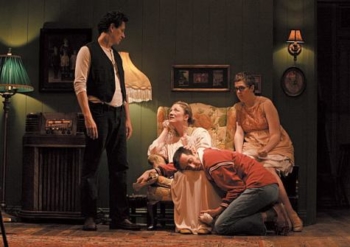
The Sound and the Fury • Press
- The New York Times May 21, 2015
- TimeOut New York January 20, 2015
- Entertainment Weekly May 21, 2015
- Theatermania May 21, 2015
- Exeunt Magazine May 21, 2015
- New York Post May 21, 2015
- New York Daily News May 22, 2015
- Theater Pizzazz! May 21, 2015
- Huffington Post May 21, 2015
- The Bergen Record May 22, 2015
- The Advertiser March 12, 2010
- The Australian March 15, 2010
- Expresso-Actual January 24, 2009
- Publico January 20, 2009
- The New Yorker May 26, 2008
- The New Yorker May 5, 2008
- The New York Times April 30, 2008
- Time Out New York April 30, 2008
- The New York Sun April 30, 2008
- The International Herald Tribune April 29, 2008
- Backstage April 29, 2008
- Variety April 29, 2008
- The New York Times April 27, 2008
- Variety November 30, 2007
- The Brooklyn Rail April 2008
- The Village Voice March 4, 2008
- Variety November 30, 2007
Authorial Intense: Elevator Repair Service Puts Faulkner On Stage — Verbatim.
by Helen Shaw
The 17-year-old experimental company Elevator Repair Service was teetering on the cusp of its big New York break two years ago. Fans of its mischievously intelligent work were spreading the word; its Gatz (workshopped at the Performing Garage) had advance buzz a producer would pawn his left ventricle for, and 15 years’ worth of European touring and downtown-insider-only hits were about to translate into the Off Broadway version of heady, wild, could-this-mean-we’re-solvent success.
But Gatz, an eight-hour uncut reading of The Great Gatsby, ran afoul of F. Scott Fitzgerald’s estate, which had licensed a conventional adaptation with hopes for Broadway. Protest as ERS might, Gatz was deemed competition and banished, first into a workshop production, and then to Philadelphia (the closest ERS got to New York was last year’s Live Arts Festival). Now, artistic director John Collins and his band of off-kilter performers return to make their delayed Off Broadway debut. Did they learn their lesson? Not a bit. This week they charge back with yet another novel in hand, taking the same verbatim approach to the first chapter of William Faulkner’s The Sound and the Fury.
For those who haven’t read it (or tried and quailed), the 1929 classic tells the claustrophobic story of the Compson family, a decaying Southern clan turning to drink, suicide and ruin. Benjy (dually played by Suzie Sokol and Aaron Landsman) is the “idiot” telling their tale—a severely autistic child whose memories spill out without any concern for cause or effect. A flicker of fire will make the 33-year-old Benjy suddenly recall a moment three decades before, for example, and Faulkner rarely alerts us to his chronological shifts.
ERS’s production may run a mere two and a half hours, but audiences can still expect a challenge. The company eschews certain tenets that theatergoers take as gospel: Even in the posh environs of New York Theatre Workshop, the set pieces are mostly salvage (“We found this table 12 years ago in our loft on 30th Street,” Collins reminisces fondly, “but now we’ve reinforced it with steel”), and choices like accents and acting style vary wildly from performer to performer. In order to match the dizziness created by the chapter’s narrative wormholes, ERS also trades roles among actors, so that, for example, four women play Benjy’s beloved sister, Caddy. Characters are still identifiable, since every Caddy said remains intact. But watchers must also key into Caddy’s gentleness to see how her solicitude stays constant, even when every physical characteristic has shifted. In this way, the audience experiences life the way Benjy does.
The company gravitated toward the project with a combination of ambition and grit. “We’ve chosen the most infamously confounding piece of American writing there is,” admits Ben Williams, a white actor who plays both Luster, a black teen, and the Compson paterfamilias. Williams is the one who brought in a documentary about West Virginian clog dancing, some of which has worked its way, viruslike, into the show’s DNA. Collins likes to pepper ERS shows with these odd, arch dances—although they can be a hazard to life and limb. “Last summer, Mike Iveson [who plays Benjy’s brother Quentin] broke his rib in a moment of being completely retarded,” recalls Williams. “He was doing a dance move that we called ‘the Gay Rabbit’ over the back of the couch. He had just said that there was never a joke that didn’t benefit from going too far—and then he broke it.” Collins remarks dryly: “I eliminated that move.”
Collins insists that this is the only way he can work, gathering found furniture and accents and bits of movement, then collaging them into a piece. His long service as a sound designer for the Wooster Group taught him this magpie method, but it also has made him as much a composer as a director. “My job is to keep the voices moving, to help us go completely into Benjy’s experience—which is usually an aural one—so that it takes over our world as well,” asserts Collins. “The task is really orchestration.”
Audiences should approach the work as though it’s a symphonic construction tracing themes and variations, as they are taken up by different instruments (or actors). The musicality comes from the blend of accents. “We’re all rednecks!” Collins exclaims. “I’m from Georgia; Vin Knight is from Louisiana; Ben is from Tennessee. These guys have this stuff in them just waiting to come out.” And Collins knows from drawing performances out of unusual places: In 2000’s Highway to Tomorrow, he cast a small metal thermos with googly eyeballs. Here, the vacuum insulation is of the emotional kind. For ERS, that’s going mainstream.
View the original article on Time Out’s website here .